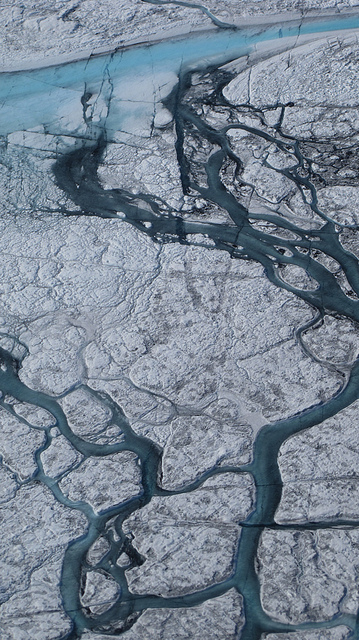What Greenland’s Melting Glaciers Mean for Cities Around the World
Greenland’s melting glaciers may someday flood your city.
With temperatures around the world climbing, melted waters from the continental ice sheets of Greenland and Antarctica are raising sea levels. Those ice sheets are melting from both above and below.
Much of the ice lost from ice sheets comes from a process called “calving,” where ice erodes, breaks off, and flows rapidly into the ocean. A large volume of ice is also lost from ice sheets melting on their surfaces according to NASA.
The tangible effects of global warming are already evident around the world, contributing to droughts that fueled forest fires in southern Europe and exacerbating hurricanes that devastated the Caribbean this summer, according to CNN. Hurricane Maria landed in Puerto Rico on Sept 20 and tore through the commonwealth, leaving millions homeless, without food or power.
The impact of rising waters in the long term could be far more damaging.
The melting glaciers largely affected North America; the 2017 Atlantic hurricane season has been energetic with Hurricanes Harvey and Irma making landfall on the continental United States. The heat transported by the two large tropical systems, however, is not directly linked to the large September 15 spike, according to the National Snow and Ice Data Center; Hurricane Harvey made landfall on August 25 and Irma on September 10.
Greenland contains enough ice to raise global sea levels by 20 feet (6 meters) if it all melted, NASA said.
Chemistry teacher Chris Peliccia expressed his thoughts on global warming.
“Only relatively recently have we developed global climate models to wrap our minds around what is happening,” he wrote in an email. “Only recently (yes, we’ve been cranking it out since the industrial revolution, but only in the last ~100 years has enough accumulated – and much more has accumulated very recently due to rapidly industrializing nations) have we generated enough CO2 to make a difference.”
“We’re now a planet of ~8 billion people with a much larger CO2 footprint,” he said. “And only now are the cumulative effects of higher global temps, rising sea levels, increased drought, milder winters, warmer summers, more severe storms, etc. beginning to build up in such a way that we cannot ignore them.”
“The issue is no longer the science,” Peliccia added. “The science of the cause and consequence of global climate change is absolutely irrefutable. The issue is the political will to make changes. We need to invest heavily and immediately in carbon neutral energy generation such as wind and solar. We need to investigate viable carbon-capture technology to sequester existing greenhouse gases in the atmosphere.. We need to protect infrastructure from the next super storm that will blow through.”
Research based on observations from the NASA/German Aerospace Center’s twin Gravity Recovery and Climate Experiment (GRACE) satellites indicates that between 2002 and 2016, Greenland shed approximately 280 gigatons of ice per year, causing global sea level to rise by 0.03 inches (0.8 millimeters) per year according to NASA.
Sophomore Sam Strout expressed his concern towards the melting glaciers.
“The melting of the glaciers is very concerning to me, because my hometown [Manchester-by-the-Sea, Massachusetts), is right on the water,” he said. “Losing the coastlines means losing my home and the memories made there. Not to mention the countless coastal cities that will have to deal with property loss and displacement.”
If the ice sheet covering Greenland was to melt completely — a process scientists believe could take several hundred years at the current rate — sea levels, NASA explained, could rise by as much as 24 feet.
The three most threatening glaciers are Jakobshavn Glacier on Greenland’s central western coast, Petermann Glacier in its far northwest and Zachariae Glacier in the far northeast. Zachariae is part of a massive feature known as the Northeast Greenland Ice Stream, which reaches all the way to the center of the ice sheet and through which fully 12 percent of Greenland’s total ice flows, according to The Washington Post.
Mark Woort-Menker is a PG student from Fort Lauderdale, Florida. He is originally from Westchester, New York and just moved to Florida. He enjoys playing...












